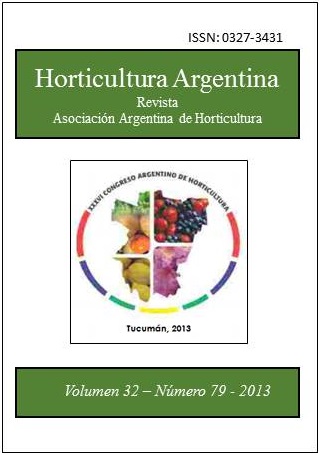Ver ítem
- xmlui.general.dspace_homeCentros Regionales y EEAsCentro Regional Mendoza - San JuanEEA La ConsultaArtículos científicosxmlui.ArtifactBrowser.ItemViewer.trail
- Inicio
- Centros Regionales y EEAs
- Centro Regional Mendoza - San Juan
- EEA La Consulta
- Artículos científicos
- Ver ítem
Efectos de la fecha de siembra y trasplante y la densidad de implantación de miniraíces de zanahoria sobre la producción de semillas = Effects of sowing and transplant date and planting density of carrot stecklings on seed production
Resumen
El empleo de miniraíces es una alternativa para implantar el cultivo
de zanahoria destinado a la producción de semillas. Para su
utilización se necesita establecer la fecha de siembra y trasplante
y la densidad de plantación a campo de las miniraíces. Con este
objetivo se realizaron ensayos en San Carlos, Mendoza (S 33º 42’;
O 69º 04’), durante las temporadas 2009-2011 y 2010-2012 con
la cv. Beatriz INTA. Las fechas de siembra en ambos años
[ver mas...]
El empleo de miniraíces es una alternativa para implantar el cultivo
de zanahoria destinado a la producción de semillas. Para su
utilización se necesita establecer la fecha de siembra y trasplante
y la densidad de plantación a campo de las miniraíces. Con este
objetivo se realizaron ensayos en San Carlos, Mendoza (S 33º 42’;
O 69º 04’), durante las temporadas 2009-2011 y 2010-2012 con
la cv. Beatriz INTA. Las fechas de siembra en ambos años fueron
a principios de los meses de diciembre, enero y febrero y las de
trasplantes a principios de abril y agosto con diseño en parcela dividida.
Las densidades probadas fueron 16,7, 8,3 y 5,6 plantas·m-2.
Antes del trasplante se determinó el tamaño de miniraíces y luego,
durante el cultivo, la brotación, la floración, el número de plantas
a cosecha y el rendimiento y calidad de semillas. Se determinó la
significancia de cada factor y la interacción. El peso fresco de las
miniraíces aumentó con el adelanto de la siembra y el retraso del
trasplante. El porcentaje final de plantas florecidas fue superior
con el trasplante de agosto. El rendimiento de semillas por unidad
de superficie en los dos años fue mayor con la máxima densidad
y la siembra de febrero con trasplante en agosto. Las características
de las miniraíces obtenidas con la combinación siembra de febrero
y trasplante de agosto, para el primer y segundo año respectivamente,
fueron las siguientes: peso fresco 8,3 y 7,5 g, diámetro
superior 16,0 y 14,7 mm, largo 6,2 y 6,6 cm, brotación 69,5
y 88,1 % y floración 82,8 y 94,7 %.
[Cerrar]
Carrot seed production is an important seed activity in the arid
central west of Argentina. Stecklings are small roots produced by
growing a crop from seed sown at high density. When carrot stecklings
are planted, they develop into large plants suitable for seed
production. The goal of this study was to determine the effects of
sowing and transplant date moreover, crop planting density of
steckilngs on carrot seed production. The assay was carried
[ver mas...]
Carrot seed production is an important seed activity in the arid
central west of Argentina. Stecklings are small roots produced by
growing a crop from seed sown at high density. When carrot stecklings
are planted, they develop into large plants suitable for seed
production. The goal of this study was to determine the effects of
sowing and transplant date moreover, crop planting density of
steckilngs on carrot seed production. The assay was carried out at
La Consulta, Mendoza (S 33º 42’; W 69º 04’) during two years
with the cultivar Beatriz INTA. It was assayed three sowing dates
for stecklings production: December, January and February. Then,
mini-roots were transplanted at two different dates: April and August
with three distinct densities (16.7; 8.3 and 5.6 steckings·m-2),
the split plot design was adopted. The variables measured before
transplant was steckilngs size, and after transplant sprout roots and
plant flowering percentage. Also was determined, plant number at
harvest, seed yield per plant and area, and seed quality. For statistical
purposes, a factorial analysis with tree factors was performed.
Results demonstrated that stecklings fresh weigh decreased as sowing
date is delayed, while it increased at the August transplant.
August transplanting increased flowering. High density, February
sown and August transplant, produced the highest yields per area
in both years, at this moment the stecklings characteristics, at first
and second year, were: fresh weigh 8.3 and 7.5 g; diameter 16.0
and 14.7 mm; large 6.2 and 6.6 cm; sprouting 69.5 and 88.1 % and
flowering 82.8 and 94.7 %.
[Cerrar]

Autor
Fuente
Horticultura argentina 32 (79) : 5-13. (Sep.-Dic. 2013)
Fecha
2013
Editorial
Asociación Argentina de Horticultura
ISSN
0327-3431
1851-9342 (Online)
1851-9342 (Online)
Formato
pdf
Tipo de documento
artículo
Palabras Claves
Derechos de acceso
Abierto
 Excepto donde se diga explicitamente, este item se publica bajo la siguiente descripción: Creative Commons Attribution-NonCommercial-ShareAlike 2.5 Unported (CC BY-NC-SA 2.5)
Excepto donde se diga explicitamente, este item se publica bajo la siguiente descripción: Creative Commons Attribution-NonCommercial-ShareAlike 2.5 Unported (CC BY-NC-SA 2.5)


